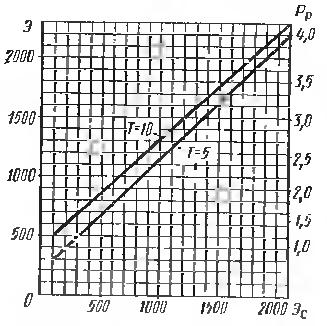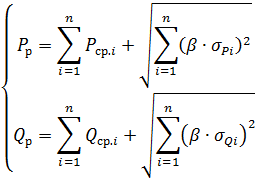Determination of design loads for industrial enterprises and rural areas
 The amount of power, the location and type of electrical receivers determine the structure of the circuit and the parameters of the power elements of industrial enterprises and agriculture.
The amount of power, the location and type of electrical receivers determine the structure of the circuit and the parameters of the power elements of industrial enterprises and agriculture.
In design, three types of loads are usually defined:
1. Arithmetic average for the busiest shift PSrmax and annual average PSr The amount of PSrmax needed to determine the calculated active load Pp and the amount of PSr. To determine annual electricity losses.
2. estimated active Pp and reactive Pp values are necessary for the calculation of networks according to the conditions of permissible heating, the choice of power of transformers and converters, as well as for determining the maximum power losses, deviations and voltage losses;
3.maximum short-term (starting current) This value is necessary to check voltage fluctuations, determine the starting current of current relay protection, select fuses and check electrical networks in accordance with the conditions of self-starting of motors
Average loads.
To determine the average power for the busiest shift PSrmax, the electric receivers (ED) of the power system node in question are divided into m groups according to the characteristic values of the utilization coefficients kisp and power cosφn.
Then for each group


where PNe.m- nominal power of the working electric drives of group m, reduced by EP of intermittent mode to long-term mode:

Here Py — installed capacity; PV — duration of inclusion of the passport, approx. e.
Then the average displacement power for the node is equal to:


where
 — total reactive power of compensating devices (Bdv — reactive power of synchronous motors; Vb — capacity of capacitor banks).
— total reactive power of compensating devices (Bdv — reactive power of synchronous motors; Vb — capacity of capacitor banks).
The average resistive load of step-down transformers (20-6 / 0.4 kV) is determined in the same way, but with the addition lighting loads:

where kc.o — demand coefficient; Pe.o — the total installed power of the lighting load.
Estimated loads of industrial enterprises.
There are several methods for determining the design load:
• specific energy consumption;
• technological work schedule of energy consumers;
• statistical
• stacked charts.
Let's look at the main provisions of the above methods.
1. Specific method of electricity consumption.When this method is used, the phase load of the busiest work shift is taken as calculated. PSrmax

where Makm. — the volume of production per shift;
Specific energy consumption in the EU per unit of production;
Tcm is the duration of the busiest shift.
2. Method of technological schedule. For groups of electric consumers with automated or strictly rhythmic flow production, the calculated load is determined by the general load schedule, which is built on the basis of the technological schedule of work of individual electric consumers and their respective capacities.
3. Statistical method. Assuming that the normal distribution law can be applied in calculating loads, the calculated load is given by Eq.

where Pcf — average value (mathematical expectation) of the load for the considered time interval;
β — the accepted multiplicity of the scattering measure (reliability coefficient of the calculation);
σtIs the standard deviation of the load averaged over the interval T = 0.5 h. If we assume that the expected load with a probability of 0.005 may exceed the value Pp, then according to the integral curve of the normal distribution β= 2.5; if the probability is 0.025, then β=2.0 .
4. Stacked Chart Method. This method is the main one for determining the design loads of industrial enterprises. Here

where km — coefficient of maximum load;
ki- the coefficient of use of a given group of n electric receivers;
Pnom is the nominal power of all considered electric receivers n.
Meaning km depending on the utilization factor and the effective number of energy consumers (no) can be found on the curves km = f (ki, no) or according to the table.
Estimated rural loads.
In order to determine the loads at different points of the agricultural electricity supply system, the loads at the inputs of individual consumers are calculated. Loads at the entrances of consumers with lighting only and no more than three powering electrical receivers can be assumed to be approximately equal to the arithmetic sum of the installed capacities of electrical receivers and lighting. Loads from groups of rooms with comparable power are determined taking into account the simultaneity coefficients co... Loads at the entrances to residential premises in rural areas are according to the nomogram (Fig. 1).

Rice. 1. Dependence of the specific design load (kW / house) at the input of a country house and the annual consumption of electricity (kWh / house) for the forecast period (years) on the annual consumption (kWh / house)
When designing external networks of 0.38 kV, the calculated loads at the entrance of rural residential buildings with electric stoves are assumed equal to 6 kW, and with electric stoves and boilers - 7.5 kW. Domestic air conditioning loads are taken into account by increasing the calculated loads at the entrances of residential houses by 1 kW.
For newly electrified settlements, as well as in the absence of information on the consumption of electricity in electrified houses, the load at the entrances to the houses is calculated:
a) in settlements with mostly old buildings (more than 60% of houses built more than 20 years ago) with gasification — 1.5 kW, without gasification — 1.8 kW,
b) with mostly new buildings with gasification — 1.8 kW, without gasification — 2.2 kW.
c) for newly built comfortable apartments in cities, urban-type settlements, settlements with large livestock and other complexes with gasification — 4 kW, without gasification — 5 kW.
According to the guidelines for calculating electrical loads in networks with a voltage of 0.38-110 kV for agricultural purposes, it is recommended that the calculated active (reactive) loads be determined by a statistical method, that is, from the average power and the deviation of the calculated load from the average:

where PSri, ВСri - the average value of the daily or evening load at the entrance of the i-th user, in the i-th part of the line, in the buses of the i-th substation.
To determine the calculated loads on 0.38 kV networks or 35-10 / 0.38 kV substations, statistical data on the loads (,,,) of all considered consumers for both daytime and evening maxima are used. The summation is done separately for evening and daytime loads and the largest total design load is selected

When determining the loads of 10-110 kV networks, the summation of the loads of transformer substations (TS) is carried out hourly according to typical daily schedules of active and reactive power, taking into account seasonality (day and evening maxima are not taken into account separately).
In the absence of reliable statistical data on loads, it is recommended to use a calculation method based on the application of the simultaneity factor (the ratio of the combined maximum load to the sum of the maximums) of the loads of individual users or their groups in the form


where Рр.д, Рр.в — respectively, the calculated daytime and evening loads on the linear section or buses of the transformer substation; ko — simultaneity coefficient; Rd.i, Pv.i - day, evening loads at the entrance of the i-th user or the i-th network element.
It is allowed to determine the design loads in one mode: during the day when summing up industrial users or in the evening when summing up household users.
The latter expressions are only recommended for homogeneous users. In the case of a mixed load, the loads on the network sections with residential buildings, industrial, public and municipal enterprises are determined separately, using the corresponding simultaneity coefficients.
The values of the power factor in the sections of networks 10-110 kV are determined depending on the ratio of the design loads of industrial users to the total design load PΣ... Meaning PΣ calculated as the sum of the loads of industrial and municipal users, determined by the calculated bus loads of transformer substations.
